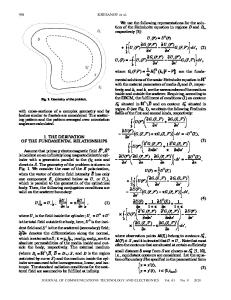Solution of the Boundary-Value Problem of Heat Conduction with Periodic Boundary Conditions
- PDF / 1,059,416 Bytes
- 14 Pages / 594 x 792 pts Page_size
- 49 Downloads / 451 Views
SOLUTION OF THE BOUNDARY-VALUE PROBLEM OF HEAT CONDUCTION WITH PERIODIC BOUNDARY CONDITIONS F. Kanca1,2 and I. Baglan3
UDC 517.9
We investigate the solution of the inverse problem for a linear two-dimensional parabolic equation with periodic boundary and integral overdetermination conditions. Under certain natural regularity and consistency conditions imposed on the input data, we establish the existence, uniqueness of the solution, and its continuous dependence on the data by using the generalized Fourier method. In addition, an iterative algorithm is constructed for the numerical solution of the problem.
1. Introduction The investigations of mathematical models for numerous important applications such as chemical diffusion, applications in heat conduction processes [5, 8], population dynamics, thermoelasticity, medical science, electrochemistry, engineering, wide scope, chemical engineering [9], and control theory require the analyses of twodimensional parabolic partial differential equations with nonlocal boundary conditions [13, 14, 17]. Inverse problems are defined as problems of finding an unknown property of an object (or a medium) according to the data of observation of the response of this object (medium) to a probing signal. Thus, the theory of inverse problems gives a theoretical basis for remote sensing and nondestructive testing. If, e.g., an acoustic plane wave is scattered by an obstacle and one observes the scattered field far from the obstacle, or in a certain external region, then the inverse problem is to find the shape and material properties of the obstacle. These problems are important for the identification of flying objects (airplanes, missiles, etc.), objects immersed in water (submarines, shoals of fish, etc.), and in many other situations. In geophysics, an acoustic wave is sent from Earth’s surface and the scattered field is collected on the surface for various positions of the source of the field at a fixed frequency, or at several frequencies. The inverse problem is to find subsurface inhomogeneities. In technology, the researchers measure the eigenfrequencies of a piece of material, and the inverse problem is to find defects in this material, e.g., hole in the metal. In geophysics, the role of inhomogeneity can be played by oil deposits, caves, mines, etc. In medicine, this may be a tumor or some abnormal objects in the human body. If it is possible to detect inhomogeneities in a medium by analyzing the scattered field on the surface, then it is not necessary to drill holes in the medium. This, in turn, makes it possible to avoid costly and destructive evaluations. The practical advantages of remote sensing make the inverse problems important, as indicated in [20]. There are several methods aimed at the numerical approximation of two-dimensional parabolic inverse problems. In [13], the author considered three different implicit finite-difference schemes for the solution of the twodimensional parabolic inverse problem with temperature overspecification. These schemes were developed
Data Loading...











